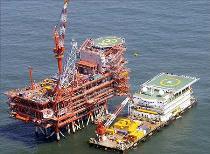 The upstream companies, such as, Oil and Natural Gas Corporation, Oil India Limited and GAIL, have already been asked to bail out the oil marketing companies by sharing their under-recoveries of about Rs 145 billion (Rs 14,500 crore) on account of petrol and diesel sales. The additional burden of Rs 16,000 crore on the upstream companies is proposed to take care of the oil marketing companies' under-recoveries on sales of kerosene and liquefied petroleum gas.
The upstream companies, such as, Oil and Natural Gas Corporation, Oil India Limited and GAIL, have already been asked to bail out the oil marketing companies by sharing their under-recoveries of about Rs 145 billion (Rs 14,500 crore) on account of petrol and diesel sales. The additional burden of Rs 16,000 crore on the upstream companies is proposed to take care of the oil marketing companies' under-recoveries on sales of kerosene and liquefied petroleum gas.
The total burden of under-recoveries (the gap between the government-fixed retail fuel prices and refining, marketing and other costs) on upstream oil and gas PSUs therefore will go up to Rs 305 billion (Rs 30,500 crore) in the current financial year. For the upstream oil and gas companies, however, this burden will not be more than last year, when they had compensated the oil marketing companies' under-recoveries to the tune of Rs 329 billion ( Rs 32,943 crore). Even after taking the additional hit, these companies will remain profitable.
The total under-recoveries on account of subsidised prices of petroleum products during 2009-10 are estimated at Rs 455 billion (Rs 45,500 crore). While two-thirds of the under-recoveries will be borne by the upstream oil and gas PSUs, the government has paid for only Rs 149.54 billion (Rs 14,954 crore) as oil subsidy for the current financial year.
The ministry of finance is expected to stick to its position of Rs 14, 954 crore subsidy for 2009-10 as against a demand of Rs 310 billion (Rs 31,000 crore) from the ministry of petroleum and natural gas. "From our side, the full settlement for this year has already been done," said a senior finance ministry official, citing the revised estimates of Rs 14,954 crore tabled in Parliament on February 26. The government subsidy, in the form of bonds, amounted to Rs 712.92 billion ( Rs 71,292 crore) in 2008-09, while the upstream companies bore Rs 329.43 billion (Rs 32,943 crore).
Explaining why the finance ministry may not be able to accommodate the request to provide more subsidy from the exchequer, the official said the government had already revised its indirect tax collection target downwards by Rs 250 billion (Rs 25,000 crore) and there might be a shortfall even on the direct tax front. There was no scope for more subsidy. "The ministry of petroleum will have to make suitable adjustments," he added.
The petroleum ministry, on its part, is still hopeful of a rethink by the ministry of finance. Officials said the calculations had not yet been finalised. When asked whether the three upstream companies would be asked to bear the additional burden, a senior petroleum ministry official said, "We will take stock in April based on the average of the last fortnight of March. It is premature to say anything now."
A senior ONGC executive said, "We have not heard about such a move from the government so far. We hope that the current subsidy sharing mechanism (under which upstream companies bear only auto fuel subsidy) continues." ONGC, GAIL and OIL have already paid Rs 83.64 billion (Rs 8,364 crore) to the marketing companies on account of petrol and diesel subsidy for the first nine months of 2009-10.
Although no decision has so far been taken, there were limited options for the petroleum ministry - either the marketing companies post a higher loss or the upstream companies pay up more. "If the government does not make more allocation for under-recoveries, we expect the downstream to bear larger part of the losses. Consequently, they will not make profits this year as was expected at the beginning of the year. If the upstream is directed to shell out more for LPG and kerosene losses, they will still make profits but it will be negative for their share prices," said Deepak Pareek, an analyst at Angel Broking.
The matter is expected to be taken up at the minister level. The petroleum ministry is quoting the Cabinet decision of July 2009 in which the government decided to bear the subsidy burden on account of LPG and kerosene sales. The upstream companies were to share only the revenue loss on petrol and diesel. Of the Rs 455 billion (Rs 45,500 crore) total revenue loss estimated for 2009-10, kerosene and LPG would account for Rs 310 billion (Rs 31,000 crore), while the share of auto fuels would be Rs 145 billion ( Rs 14,500 crore).
The subsidy numbers have been estimated on the annual crude oil price average of $70 a barrel. The department of expenditure, which is part of the ministry of finance, will also carry out the annual ritual of auditing the subsidy numbers, provided by the oil marketing companies, some time in April-May.
The upstream companies are asked to share the subsidy by giving a cash discount on crude oil and LPG sold to the marketing companies, on the ground that they benefit from the upside in international oil prices.










